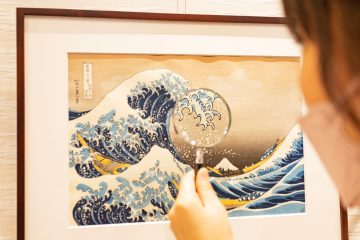SPECIAL
My First Osaka
From Kire & Hirano, Osaka – Part 2:
Exploring Osaka’s Shitamachi Old Town♪

2023.11.24
Hi! My name is Nasu. I came from South Korea to do Working Holiday in Japan.
After a cool cultural experience at Nyoganji Temple in Part I, my friend, Ji won, and I headed out to explore the old town of Kire and Hirano.

Nasu

Ji won
100 Year Old Town of Kire

We used a map to navigate the way to Nyoganji Temple from Osaka Metro’s Kire-Uriwari Station. On the way back, we put the map away and took a stroll around the town of Kire.

Many think of Osaka as a busy metropolis with lots of people and gourmet food, a great place to shop for high fashion brands or find bargain deals at Don Quixote. But the town of Kire, still part of Osaka City proper, is a true shitamachi, literally meaning “low town”, an old town where a community of ordinary citizens have lived for centuries. The scenery and even the air in Kire is completely different from that of Umeda, Namba, or Shinsaibashi. This slower paced part of Osaka is rich in culture and history, reminiscent of the good old Japan.


Houses, gates, and walls that were constructed over 100 years ago still remain intact all over Kire. I’m starting to think the gods and deities of the shrines and temples in the area that are as old are specially keen on protecting these historical buildings.

Nyoganji Temple where my friend Ji won and I experienced Japanese tea ceremony and calligraphy in Part1 is one of the historical buildings here. It serves as a place of recreation and relaxation for the locals.

Street guides can be found on the street corners of Kire, providing helpful historical backgrounds as well as explanations about kominka, traditional Japanese folk houses. According to the street guide, it is rare in Osaka to find so many kominka in one area.

To me, these planters and little gardens in front of a house are very traditionally Japanese. No one does that in South Korea.
Apparently, this whole area used to be what the Japanese call joka-machi, a castle town, of Kire Castle that’s unfortunately long gone. Makes sense why this area has so many elements of the good old Japan. I love the quaint traditional Japanese streetscape.
Osaka Metro Hirano Station


We’d done a lot already—Japanese culture workshops, exploring a historic castle town—and we were getting hungry! So we hopped on Osaka Metro and took the subway to Hirano, the next station over. Just like Kire Uriwari, Hirano is an old town of Osaka—with a great lunch spot!

Handmade Udon Noodles at Rokurokuyaya♪

We headed straight to Rokurokuyaya in an old shotengai shopping street.
Rokurokuyaya is famous for their handmade udon noodles and its tasty dashi broth, a requirement for a good Japanese cuisine, and fans come from afar eat their noodles. I’d heard about this place and wasn’t going to pass up on the chance to try their noodles since I was in the area.


I liked the retro interior design from the Showa era, using lots of wood. The shop even has a little Japanese garden you can relish as you savor your noodles.

Nanshuka Mori Teishoku, one of their set lunch menus comes with a bowl of udon noodles, a bowl of rice (white or seasoned), and 4 bowls of sides for only 850 yen. I liked that you can try a variety of side dishes.

Ji won ordered the curry udon noodle lunch set with vegetable tempura. Very hearty, 950 yen. The spice of curry and the flavor of dashi together create a gentle flavor, easy for those who may not be the biggest fan of hot and spicy.
A nice range of set lunch menus are offered at Rokurokuyaya. They all looked good. There currently is no English menu since the price update, but no worries. Staff is there to help you♪

In addition to their famous udon noodles, Rokurokuyaya is also known for their donuts, conveniently sold among a variety of foods over the counter at their storefront. I had also heard they sell Japanese wagashi and had planned to take home some mitarashi dango (rice dumpilngs with sweet soy based glaze) and ohagi (sticky rice balls with sweet azuki paste, sometimes dusted with soy bean powder or ground black sesame seeds) but, unlucky me, they were all sold out 🙁
Donuts were priced at 120 yen and up. Very reasonable. The donut menu includes plain, stuffed with sweet azuki beans or apples, covered in sugary glaze, etc. No egg is used in any of these donuts to make it allergen-free. Tofu is used in place of eggs, making the donuts healthy and giving it a milder flavor. I have to come back for them another time!

It was already past lunch time, but we saw lots of people come by to pick up bento boxes and ready-to-eat deli items. It was obvious the locals frequent this place.
Next time I come here to explore more of the town, I hope they are not sold out of the donuts!
A Museum of Newspaper in Hirano


Among many museums that reside in Hirano, we found the Newsagent Museum, a museum of newspaper, as we strolled down the shotengai shopping street of Rokurokuyaya.

Built in 1929, the building is actually a working newspaper distributor that has been designated by the Japanese government as a Registered Tangible Cultural Property. I liked the retro modern style exterior of the building. It looked really cool.
A Town of Retro Architecture and Unique Museums


This area is actually known as the Whole Town Museum of Hirano. It is part of the revitalization efforts to help local residents enjoy and rediscover their town. It was a pleasant surprise to find some 15 permanent museums nestled in the area, including the Living Museum, the Sword Museum, and the Post Office Museum.
During the past wars, the town of Hirano survived the ravages of the wars and that helped to preserve its infrastructure and history. There was so much to see in this small area! I think a favorite of Ji won’s, who is a varistor by profession, was the Coffee Shop Museum.
Slow Paced Osaka☆彡


It was my first time visiting the Kire and Hirano area. I made lots of discoveries and I think I’ve fallen in love with this town. I’ve always liked—and I always will like—the bustling metropolitan Osaka, but I also enjoyed strolling around and exploring unique findings in the old town of Kire and Hirano. This is another side of Osaka I didn’t yet know, a slow paced Osaka.

I even made a new friend there today♪
Spots Introduced
Rokurokuyaya
[Access] About 8 mins walk from Tanimachi Line's Hirano Station Exit 2
[Hours] 11:00 am - 6:00 pm
※Indoor dining 11:00 am - 2:30 pm
※Take out available until sold out
[Closed] Open daily (Donuts and indoor dining are unavailable on Sundays)
Recommended Plans

The World of Ukiyo-e:
Japonism that Captured the World
In 17th to 19th century Japan, after the turbulent and violent Warring States period ended, …
2025.06.27

An epic appearance of the Milky Way in Osaka!!
A guide to a magical night on Tanabata, July 7.
Tanabata, aka the Star Festival, is one of the traditional seasonal festivals of Japan, …
2025.06.13

A Must See Summer Festival in Osaka:
The Fantastical Tenjin Matsuri
with Mikoshi, Boats, and Fireworks
The Tenjin Matsuri (Tenjin Matsuri Festival) is one of the biggest festivals in …
2025.06.06






